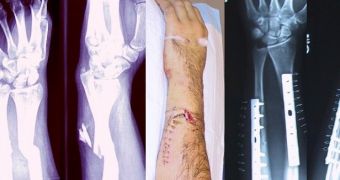Bone grafts are scaffolds used to hold bone pieces in place after a serious fracture or shattering. They can be nasty things, with pins sticking out of the flesh and skin. However, better methods are being invented all the time, and 3D printing technology has just provided a new possibility.
In truth, 3D printing technology has been used in making bone grafts before, or at least attempted bone grafts. Unfortunately, the results weren't altogether biocompatible, and they tended to warp.
You see, bone grafts are generally made out of calcium phosphate, and the current method of creating bone grafts, scaffolds as it were, out of that substance involved high temperatures.
Because of those high temperatures, drugs that can stimulate bone growth cannot be used alongside them, living cells cannot stick to them, and antibiotics don't work very well to stave off infections.
Part of the issue is the phosphoric acid used to bind the phosphate powder, and fuse it in place via sintering. Besides the temperature problem, scaffolds like this can retain binder residues. Also, during sintering some parts shrink, often unevenly, which leads to cracks.
Suffice to say, current 3D printing techniques for making bone grafts are sub-standard at best. That is why the new discovery by a team of US researchers means so much for medics and surgeons (University of Rochester, Alfred University, and the University of California San Diego).
The new method adds collagen to the phosphoric acid binder solution, creating a new composite material with the calcium phosphate. Collagen is the most abundant structural protein in the body and is a critical component of bones.
Adding it led to tougher scaffolds, which also encouraged living cells to be produced faster. They still weren't able to enable complete healing, but they did bridge bone defects properly. An adapted 3D Systems ZPrinter 450 was used in the lab tests.
All in all, the new 3D printing method has helped move the world forward towards a time when bone injuries can be fully healed with the aid of science. We still don't have a way to induce full bone (re)formation, but we are getting there ever so steadily.
In the meantime, 3D printing technology can be used for replacement implants and joint replacements. It's still (arguably fortunately) unlikely that 3D printed bioplastics or metals will ever be lobbied as desirable replacements for perfectly healthy bones, but implants can still be a godsend when a truly serious injury is sustained.

 14 DAY TRIAL //
14 DAY TRIAL //